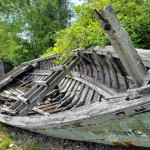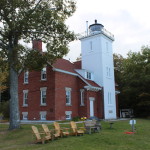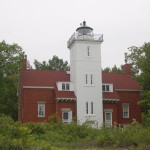
One Of The Easiest To Visit Michigan Shipwrecks Is At This Historic Lighthouse
Michigan’s Great Lakes shoreline is known for beautiful beaches, stunning sunrises and sunsets, historic lighthouses, and water perfect for swimming and boating. The Great Lakes waters that provide all of these things can also be dangerous and unpredictable, which is why our Lake Huron, Lake Michigan, and Lake Superior shorelines are also home to hundreds of shipwrecks. While many of these shipwrecks are at the bottom of the lake and require diving gear to see, some are visible on the shore and are easier to visit. One of the easiest to visit Michigan shipwrecks is the Joseph S. Fay, located on the grounds of the 40 Mile Point lighthouse museum north of Rogers City. Today we’ll take a look at this shipwreck and provide all the details you need for a visit.
The Joseph S. Fay was a 216 foot wooden steamer that was built in Cleveland in the 1870s. From the Thunder Bay National Marine Sanctuary we learn more about how it met its fate: “With the D.P. Rhodes in tow, the giant bulk freighter Joseph S. Fay encountered a strong gale in northern Lake Huron. Fay hit the rocks at 40 Mile Point, the towline parted and the Rhodes met a similar fate at Cheboygan. The Fay broke apart quickly and its lower hull still containing a load of iron ore sits in shallow water not far from shore, while a large portion of the starboard side is located on the beach just up the shore from the lighthouse.”
To get to the shipwreck you follow a well-signed path to the beach. Start at the lighthouse and head towards the beach, following the signs shown above to get to the wreck. Water levels vary and will have an effect on how much of the wreck is visible. The part of the wreck in Lake Huron is marked by an NOAA buoy seasonally and can be seen from a kayak on a clear day. It is also an excellent shallow dive opportunity for beginners. The Fay is not the only shipwreck near here as the Michigan historical marker referring to the area as “Graveyard of Ships” details: “Named by seventeenth century French explores La Mer Douce the sweet or freshwater sea, Lake Huron is the second largest of the five Great Lakes. It has over 3,800 miles of shoreline and contains 30,000 islands, among them Manitoulin, the world’s largest freshwater island. Violent storms on the “sweet sea” have made it dangerous for ships. As of 2006, 1,200 wrecks had been recorded. During the Big Blow of 1905, twenty-seven wooden vessels were lost.”
Now, a little bit about the 40 Mile Point Lighthouse. From the Michigan historical marker here: “During the late 1800s, the U.S. Lighthouse Board created a system of coastal lights along Lake Huron’s Michigan shore so that mariners would always be within sight of at least one. With a light south of Forty Mile Point on the Presque Isle Peninsula and one one to the north at Cheboygan, and eighteen mile stretch of shoreline remained unlighted and dangerous. In1890 the board recommended that a light be built at Forty Mile Point. The light was completed in 1896, and Xavier Rains served as the first keeper, The lighthouse was transferred to Presque Isle County in 1998, but the Coast Guard retained ownership of its Fresnel lens. The site was listed in the National Register of Historic Places in 1984.”
In normal years, the 40 Mile Point Lighthouse is open to visitors. The lighthouse interior has been restored and one of its apartments now features many nautical artifacts. Other outbuildings have also been restored and another highlight of the lighthouse grounds is the pilot house of the 1912 steamer Calcite. Find out more at https://fortymilepointlighthouse.org/.











